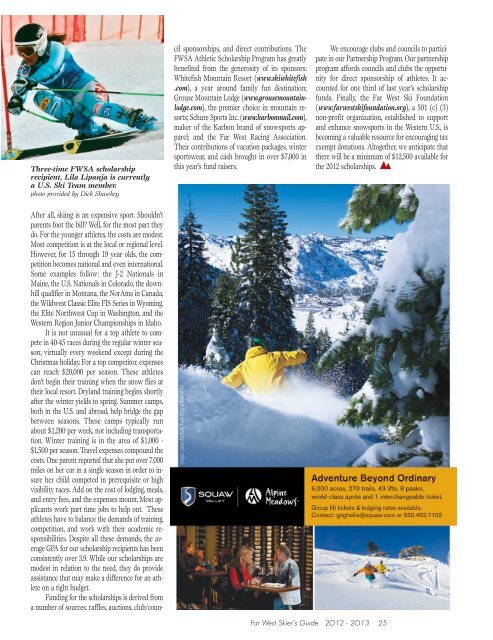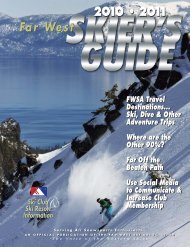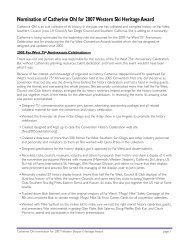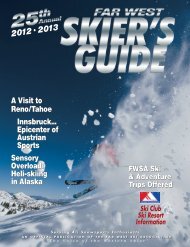Download pdf - Far West Ski Association
Download pdf - Far West Ski Association
Download pdf - Far West Ski Association
You also want an ePaper? Increase the reach of your titles
YUMPU automatically turns print PDFs into web optimized ePapers that Google loves.
Three-time FWSA scholarshiprecipient, Lila Lipanja is currentlya U.S. <strong>Ski</strong> Team member.photo provided by Dick ShawkeyAfter all, skiing is an expensive sport. Shouldn’tparents foot the bill? Well, for the most part theydo. For the younger athletes, the costs are modest.Most competition is at the local or regional level.However, for 15 through 19 year olds, the competitionbecomes national and even international.Some examples follow: the J-2 Nationals inMaine, the U.S. Nationals in Colorado, the downhillqualifier in Montana, the NorAms in Canada,the Wildwest Classic Elite FIS Series in Wyoming,the Elite Northwest Cup in Washington, and the<strong>West</strong>ern Region Junior Championships in Idaho.It is not unusual for a top athlete to competein 40-45 races during the regular winter season;virtually every weekend except during theChristmas holiday. For a top competitor, expensescan reach $20,000 per season. These athletesdon’t begin their training when the snow flies attheir local resort. Dryland training begins shortlyafter the winter yields to spring. Summer camps,both in the U.S. and abroad, help bridge the gapbetween seasons. These camps typically runabout $1,200 per week, not including transportation.Winter training is in the area of $1,000 -$1,500 per season. Travel expenses compound thecosts. One parent reported that she put over 7,000miles on her car in a single season in order to insureher child competed in prerequisite or highvisibility races. Add on the cost of lodging, meals,and entry fees, and the expenses mount. Most applicantswork part time jobs to help out. Theseathletes have to balance the demands of training,competition, and work with their academic responsibilities.Despite all these demands, the averageGPA for our scholarship recipients has beenconsistently over 3.9. While our scholarships aremodest in relation to the need, they do provideassistance that may make a difference for an athleteon a tight budget.Funding for the scholarships is derived froma number of sources: raffles, auctions, club/councilsponsorships, and direct contributions. TheFWSA Athletic Scholarship Program has greatlybenefited from the generosity of its sponsors:Whitefish Mountain Resort (www.skiwhitefish.com), a year around family fun destination;Grouse Mountain Lodge (www.grousemountainlodge.com),the premier choice in mountain resorts;Schure Sports Inc. (www.karbonmail.com),maker of the Karbon brand of snowsports apparel;and the <strong>Far</strong> <strong>West</strong> Racing <strong>Association</strong>.Their contributions of vacation packages, wintersportswear, and cash brought in over $7,000 inthis year’s fund raisers.We encourage clubs and councils to participatein our Partnership Program. Our partnershipprogram affords councils and clubs the opportunityfor direct sponsorship of athletes. It accountedfor one third of last year’s scholarshipfunds. Finally, the <strong>Far</strong> <strong>West</strong> <strong>Ski</strong> Foundation(www.farwestskifoundation.org), a 501 (c) (3)non-profit organization, established to supportand enhance snowsports in the <strong>West</strong>ern U.S., isbecoming a valuable resource for encouraging taxexempt donations. Altogether, we anticipate thatthere will be a minimum of $12,500 available forthe 2012 scholarships. ▲▲<strong>Far</strong> <strong>West</strong> <strong>Ski</strong>er’s Guide 2O12 - 2O13 25





